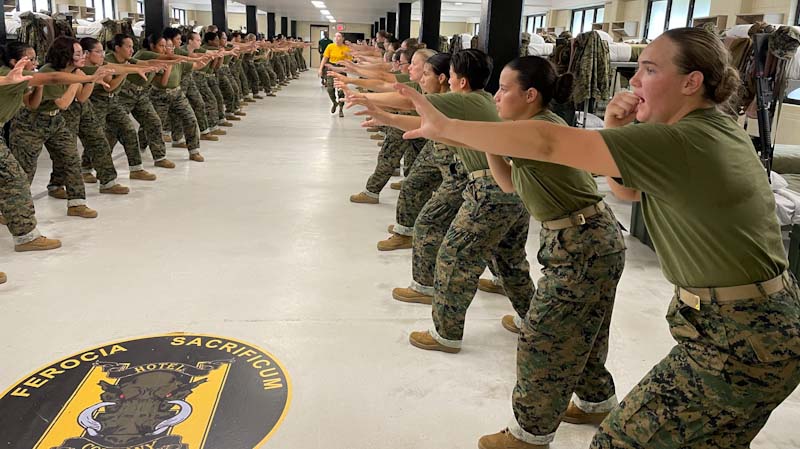Women Marines and veterans packed a field house at boot camp at Parris Island, S.C. earlier this month to watch the decommissioning of the historic Fourth Battalion.
Sgt. Maj. Christine Henning said she’ll miss the one Marine entity run almost entirely by women.
“That female legacy of only females training in one company. Training on one battalion is no more,” Henning said. “There is now no more women-only entity in the Marine Corps.”
Parris Island trained nearly every woman in the Corps. The decommissioning was part of a halting effort to end gender segregation as the service looks for ways to bring more women into the Marine Corps.
Under one name or another, the Parris Island unit trained nearly every female recruit to join the Marines since women were allowed to join in the 1940s. The Marines opted to shrink the number of battalions at Parris Island from four to three, after women finally began training on the west coast in 2021.
Men have always trained on both coasts, with recruits east of the Mississippi training in the lowcountry of South Carolina.The goal is to eventually train about half the women who join the corps in San Diego.
On the day before the decommissioning ceremony, after lightning was spotted, a platoon of women recruits trained inside their barracks. Two rows of young recruits shouted martial arts commands in unison in front of their bunks.
Normally recruits would do this training outside among platoons of men.
Men and women were kept largely separated until 2019.
The lack of contact shows up in their attitudes, said Sidra Montgomery, sociologist and senior researcher at Westat Insight. She was the lead researcher for a University of Pittsburgh study commissioned by the Marines looking at how to end gender segregation.
“We measured recruits' sexist beliefs and attitudes, and we found that male Marine Corps recruits have higher sexist attitudes than their female Marine Corps recruits and also than their other male service recruit counterparts,” she said.
The other services integrated boot camp in the 1990s. The Air Force used mixed teams of drill instructors even before the recruits were integrated.
The Marines resist that approach. Marine drill instructors train around the clock - even in the shower.
Leadership at Parris Island said that intensity is part of what makes a Marine. The vast majority of platoons are only males. The independent study by the University of Pittsburgh recommended having at least one female drill instructor, Montgomery said.
“The drill instructor is so important in the training process,” she said. “They are the apex role model of what it means to be a Marine. I think it's critically important to establish a culture that signals that men and women are to be equally respected authority figures.”
One problem is there aren’t enough female recruits or drill instructors. Women make up roughly 9% of the Marine Corps - the lowest percentage of any service.
Instructors step in
Gunnery Sergeant Kylee Gregorek was urged to report to Parris Island.
Working as an instructor at the pool, she said she was initially reluctant, but the role has grown on her.
She barked commands to a group of men and women going through swim training in boots and camouflage earlier this month.
“I love Marines, I love mentoring them. It's nice because you're kind of like that mom,” she said. “And there's like, you know, they look up to you for everything. I know it's frustrating at times, but so is being a parent.”
Outside her office at headquarters for Fourth Battalion, Lt. Col Aixa Dones explained why she shoed.
“I wanted the biggest challenge. So I joined the Marine Corps for that. But once I was in the Marine Corps, I fell in love with the institution,” Dones said.
She joined the Marines before all combat roles were opened to women throughout the military in 2015 - at the time, over the specific objection of the Marine Corps.
Dones ran Marine recruiting in the Los Angeles office before taking over as the last commander of 4th Battalion at Parris Island.
Finding steady progress
The commandant of the Marines first targeted having 10% of its force be women by 2017, but progress has been slow.
Part of the difficulty is Marines leaned heavily toward the combat roles which were closed to women only a few years ago.
“We don't have a medical service within the Marine Corps and a large number of the female populations for the Navy, the Air Force. And the Army, they go into the medical field,” Dones said.
When the last class of recruits graduated in May, Dones said she was seeing more recruits who specifically joined to go into the male-dominated infantry.
A group of three women who graduated from boot camp in the 1970s came back to Parris Island for the decommissioning ceremony. After being brought in to fill desk jobs, each of them eventually earned master’s degrees, Teri Metelak said.
“We were recruited to free a man to fight. The Marine Corps wanted a few good men. And that's the way we were actually recruited. There was not really any such active recruitment for females at our time, but it was just determination,” Metelak said.
It’s always been difficult, she adds, for women to gain a foothold in the Marines.



